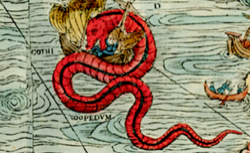Here Be Duck Trees and Sea Swine
An interactive Renaissance map filled with strange and wonderful monsters.
The first time one looks at a color print of Olaus Magnus’ 1539 Carta Marina, the eyes scan the crowded landmass and fix on the creatures in the western part of the map. Larger than the other images and framed by open space, they dominate the chart visually and stir the imagination. To us, the quaint figures rising in the northern waters of Olaus’ map of Scandinavia could be illustrations in a children’s book. However, given that maps chart human knowledge, that they provide glimpses of our understanding of the world at any point in time, Olaus’ 16th-century contemporaries would have regarded the Carta Marina sea monsters differently than we do.
When the chart was made, in the early years of the Age of Exploration, there was a lingering belief in the existence of griffins, unicorns, dragons, the phoenix, the monstrous races, and a host of other unnatural creatures. Modern science was in its infancy. Although adherents to the direct observation of nature would soon challenge hearsay and tradition and begin to classify animal life, at the time the medieval imagination was still free to shape its own forms of the natural world. The chart’s giant lobster gripping a swimmer in its claws, a monster being mistaken for an island, and a mast-high serpent devouring sailors would have represented actual fears of the unknown deep.
Those and Olaus’ other fanciful sea beasts are not mere decorations to fill empty spaces. Nor are they only visual metaphors for dangers lurking in the sea. Intended as representations of actual marine life, they are identified in the map’s key.
Through his map and its voluminous commentary, Olaus became the age’s principal chronicler of the sea serpent, the giant squid, and sea monsters in general. These representations were influential for centuries and are still discussed in our own time. They are the ancestors of the decorative whales that dot oceans on modern commercial globes.
Olaus (1490–1557) and his elder brother, Johannes, were Catholic priests who sought exile following their native Sweden’s conversion to Lutheranism during the Reformation. The brothers were living in Danzig (modern Gdańsk), Poland, when Olaus began work on a map of the northern regions in 1527, the same year that Sweden became Protestant. The work would take him nearly 12 years. Printed in Venice, Olaus’ Carta Marina was the largest, most detailed, and most accurate map of any part of Europe up to that time
The entire Carta Marina is both a sea and land map, as declared in its full title: “A marine map and description of the northern countries … ” Sea creatures graphically dominate the mass of figures on the total Carta Marina. Framed by open space, they rivet the attention of the viewer by their size and fantastic forms. Several are the stuff of nightmare, the shapes of Renaissance mariners’ fears. Among them are many unnamed “monsters.” Unlike the map’s familiar land animals, which are drawn from life, most of the Carta Marina’s sea beast figures were born of the artist’s imagination, by someone who had heard such animals described. Olaus gleaned much of his knowledge of marine life from tales told by fishermen and sailors. Standard names, drawings, and classification of species were yet to come, following systematic observation of nature.
This text was adapted from Sea Monsters: A Voyage Around the World’s Most Beguiling Map by Joseph Nigg. © University of Chicago Press, 2013.
More from Slate’s series on the future of exploration: Is the ocean the real final frontier, or is manned sea exploration dead? Why are the best meteorites found in Antarctica? Can humans reproduce on interstellar journeys? Why are we still looking for Atlantis? Why do we celebrate the discovery of new species but keep destroying their homes? Who will win the race to claim the melting Arctic—conservationists or profiteers? Why don’t travelers ditch Yelp and Google in favor of wandering? What can exploring Google’s Ngram Viewer teach us about history? How did a 1961 conference jump-start the serious search for extraterrestrial life?
